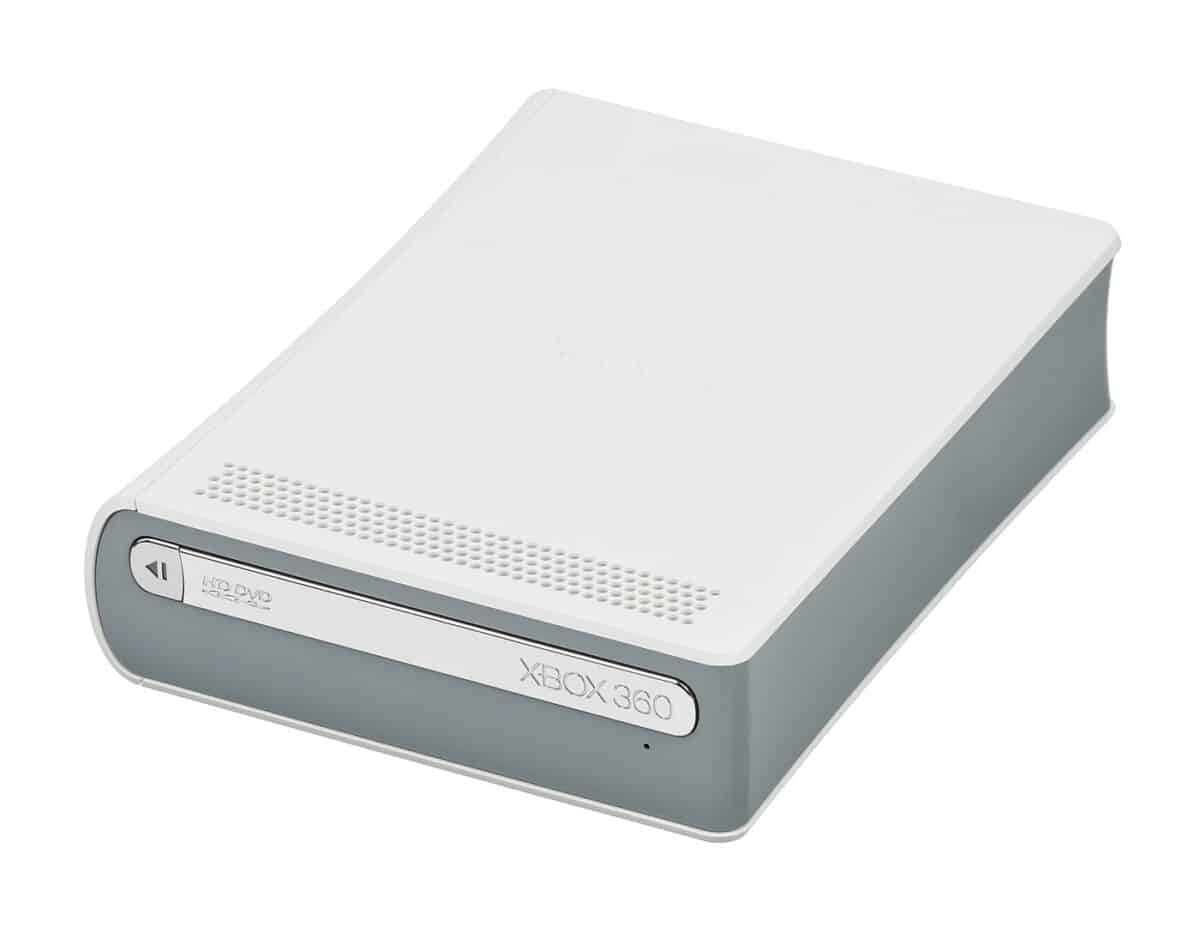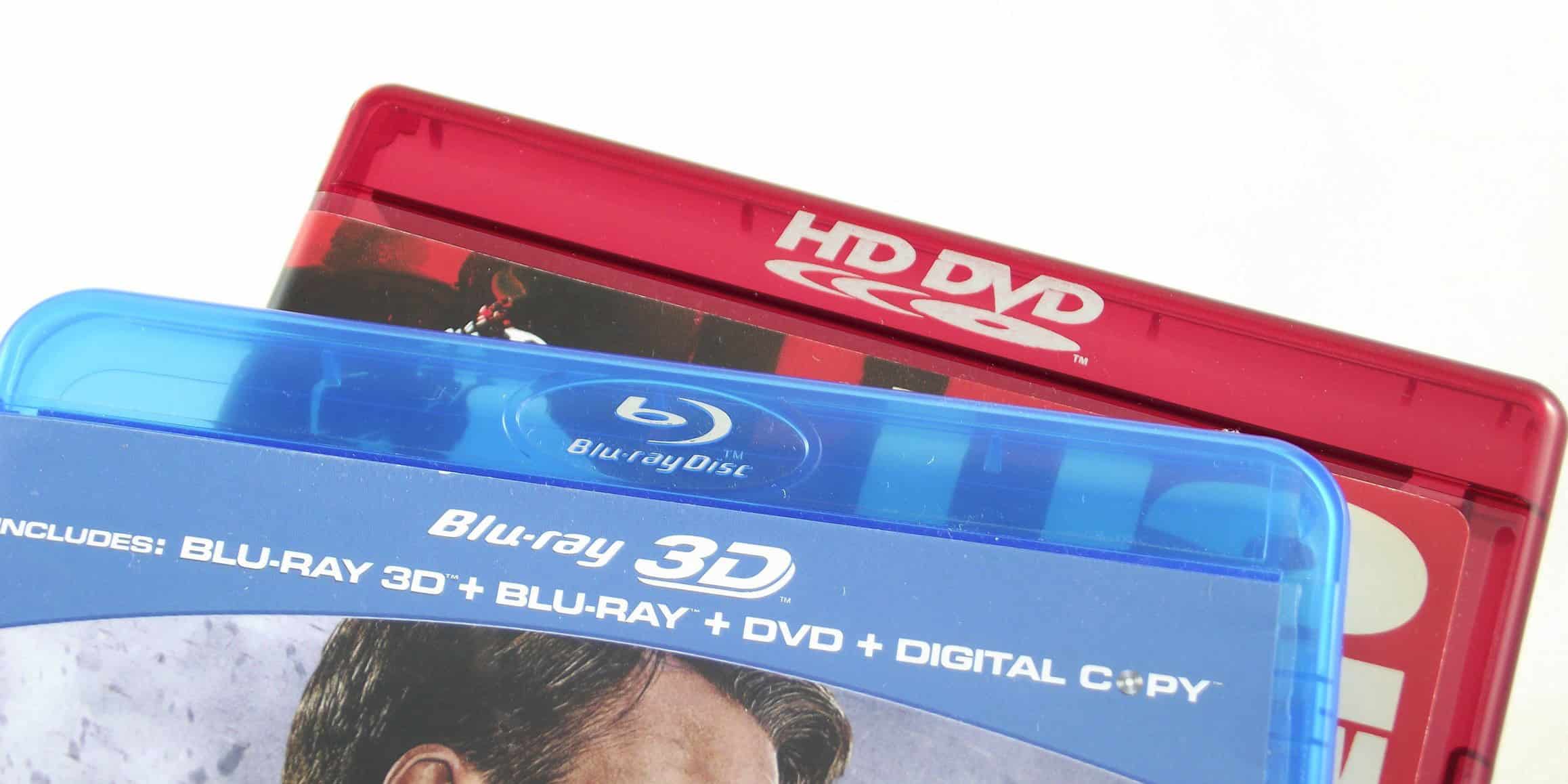It seems every major shift in home video formatting brings with it a battle. Most famously, there was Betamax vs. VHS in the 1980s. Then, there were VCDs vs. DVDs in the 1990s. More recently, there was the great showdown between Blu-ray vs. HD DVD in the 2000s. The last of these — the infamous format war of 2006-2008 — is perhaps the least discussed. How did HD DVDs come to be? What was it about Blu-rays that ultimately led to HD DVD failure? Let’s deep dive into the format’s history and the subsequent format wars.
Why HD DVD Mattered
Don’t let the fact that HD DVD failed distract from the truth. HD DVD was significant, and it had serious merit in the home video market. Prior to their release, the quality of popular home video formats — DVDs and VHS tapes — did not match the quality of the HD TVs. With the advent of the HD DVD, the commercial HD TV sets of the early 2000s finally had a way to record or playback films and television in high definition. Alongside the burgeoning Blu-ray format, the HD DVD made high-definition home video a reality.
The invention of blue lasers was a major driving force. Prior to the HD DVD and the Blu-ray, home video relied on red laser diodes. First discovered by Shuji Nakamura in the early 2000s, Blue laser diodes changed the game by bringing shorter wavelengths, higher definition, and greater storage in one. Sony was working on an early Blu-ray prototype as early as February of 2002, while Toshiba had begun work on the HD DVD by that August. The great HD format wars had officially begun, marking the first format war in over 20 years.
Why did HD DVD specifically matter in comparison to the Blu-ray? It’s clear why HD home video formats mattered on the whole, but what about HD DVD in particular? HD DVD had the full support of the DVD Forum: an organization of dozens of consumer electronics companies in the home video market. Secondly, the HD DVD also had the support of Microsoft and Intel — two major tech titans. Everything about the HD DVD seemingly spelled out a hit.
How Did People Feel About HD DVDs?

As with many leaps in technological advancement, the average consumer’s reaction to the HD DVD depended entirely on how much fun money they had to spend. Remember, many households had DVD players and VCRs in 2006. By the time the HD DVD rolled around, your typical, middle-class American family was not looking to upgrade their home movie collection for the third time in a decade. By 2006, 81% of Americans had a DVD player. Additionally, 79% had a VCR. Could this be why the HD DVD failed?
Naturally, it only makes sense that the public would feel a little skeptical about the HD DVD. While, yes, 1080p quality was an exceptional leap over the DVD’s 480p, plenty of families just didn’t care about this sort of thing. Especially when it meant upgrading not only the home video collection but also the entire home entertainment system. A new HD TV, a new surround sound system, a new disc player… It was all just far too much for your standard American consumer. Understandably so, too. It didn’t matter if a person felt good or bad about the HD DVD if they couldn’t even afford it.
One can see a similar phenomenon with 4K UHD discs. While the public undoubtedly has an interest in 4K content in streaming services, the prices associated with upgrades don’t appeal to middle-class Americans. It’s been a key issue with home video dating all the way back to the Betamax. It seems the sheer cost of a home entertainment system and collection will always take precedence over any positive reaction the public has every single time.
HD DVD Specs
| First Released | March 31st, 2006 |
| Developer | Toshiba |
| Size | 4.7 in. |
| Encoding | VC-1, H.264, and MPEG-2 |
| Audio | 24-bit/192 kHz (two channels); 24-bit/96 kHz (eight channels) |
| Storage Capacity | 15 GB (single layer); 30 GB (dual layer) |
| Quality | 1080p high-definition video |
| First Titles Released | The Last Samurai (2003), Million Dollar Baby (2004), The Phantom of the Opera (2004), Serenity (2005) |
| Predecessor | DVD |
| Successor | Blu-ray |
| Discontinued | March 28th, 2008 |
How the HD DVD Failed: A Complete History
Before the HD DVD failed, it seemed like the high-definition home video format would come out on top of the format wars. The Blu-ray predated the HD DVD by months but had virtually zero support from the tech industry. As a result, the DVD Forum — chaired by Blu-ray developer Sony — faced tremendous division within their ranks. The question was as controversial as religion or politics. Should consumer electronics companies embrace the Blu-ray in spite of the new, pricy blue lasers it demanded?
What’s more, these proprietary Blu-ray discs also came equipped with newer, more expensive protective cases. They were aesthetically distinct from the industry standard DVD caddies, not to mention drastically different in price. It was strike after strike after strike for the Blu-ray, and as a result, a faction of the DVD Forum wanted nothing to do with it. Conversely, a separate faction was all in. One group split from the DVD Forum and embraced the Blu-ray, while another stayed and worked to develop an HD home video format. Thus, the HD DVD was born.
At the time, the HD DVD seemed like the best bet. Backed by 61 general members with another 72 associate members throughout the consumer electronics industry, the support for the HD DVD easily drowned out the shouts from those in support of the underdog Blu-ray format. Still, HD DVD saw the risk of a potential format war and wanted to bring the Blu-ray supporters back into the DVD Forum’s fold. After all, war could mean the death of both formats, and nobody wanted that. An attempt at a compromise between the newly formed Blu-ray Disc Association and DVD Forum took place in 2005.
Early Signs of Imminent Failure
The peace talks between Blu-ray and HD DVD failed. Software and hardware were the bone of contention. Those in favor of the Blu-ray pushed for a Java-based interactive software, while those behind the HD DVD wanted to use Microsoft‘s new HDi software. Beyond this, there was the issue of the actual discs themselves. Because the Blu-ray and the HD DVD differed so drastically on a physical level, whoever triumphed would get to enjoy billions in royalties. It had happened with the DVD, and no one wanted to miss out on that kind of check.
The Blu-ray Disc Association refused to budge. The DVD Forum did the same. No one wanted to miss out on a fat paycheck. Talks fell through in the summer of 2005. Both the Blu-ray and the HD DVD moved ahead at full steam. They were no longer potential collaborators, but direct competitors. Only one could come out on top.
While the ultimately HD DVD failed, all the early signs suggested the Blu-ray was going to be the first casualty. For one, the HD DVD had support from Microsoft, Intel, and HP. What’s more, the HD DVD was a natural progression for existing DVD tech. The Blu-ray had less support and required more extensive, industry-wide participation from consumer tech companies to become compatible. Through all this criticism, Blu-ray backers held their ground. As it turned out, this unrelenting fealty proved fatal for the HD DVD.
The Eventual Demise of the HD DVD

As a last-ditch effort to end the format war, HP came to the Blu-ray Disc Association with an ultimatum. They would rescind their support of the HD DVD if the Blu-ray disc were to adopt Microsoft’s interactive HDi software over the Blu-ray’s preferred Java software. The Blu-ray Disc Association declined, and HP embraced the HD DVD. While insiders viewed this as the death knell for the Blu-ray, it actually became a key reason why the HD DVD failed. Blu-ray was about to win big.
By refusing HP’s offer to embrace Microsoft in exchange for exclusive support, Sony was able to put Blu-ray tech in their upcoming PlayStation 3 console. (Microsoft’s Xbox was obviously their biggest rival) The first HD DVD and Blu-ray discs hit shelves in the spring of 2006, and in the fall of 2006 — with the PS3’s release — the war was effectively over. It would take another two years for HD DVD to officially dissolve once and for all, but with the implementation of Blu-ray tech in the PS3, alliances started shifting. In buying a PS3, consumers automatically had a Blu-ray player in their homes.
This gave Blu-ray a major leg up, as your average HD DVD player was marketing for anywhere between $499 and $799. The PlayStation 3, on the other hand, retailed for $499 — and you could play next-gen games on it, too. Alliances started to shift soon after it became clear that Blu-ray might actually win this thing after all. From the biggest studios to the top rental stores to the major box stores, Blu-ray practically became the preferred format almost overnight. The Xbox 360 eventually supported HD DVD, but it had already been out for a year prior, meaning no one was going to upgrade so soon.
Why the HD DVD Failed
The HD DVD format was officially discontinued in March of 2008. The writing had been on the wall long before then, though. Truthfully, the HD DVD failed the second the PlayStation 3 was released on November 17th, 2006 — less than nine months after the format officially hit shelves. It’s fascinating to see it go down this way. (Especially considering that, at launch, both the HD DVD and the Blu-ray were essentially evenly matched. Each format had three of the Big Six studios behind them — HD DVD had Universal, Paramount, and Warner Bros. Conversely, Blu-ray had Sony, Disney, and 20th Century Fox.)
With both entering the ring with three titans each, all HD DVD needed was one big advantage to triumph over Blu-ray once and for all. As it turned out, Paramount was the first one to change allegiances in the summer of 2007. Following the success of the PlayStation 3 and the lack of HD home video support on the Xbox 360, it was only a matter of time before others jumped ship. Over the next several months, nearly every major studio and distributor changed sides and embraced Blu-ray after all. The HD DVD slowly fizzled out.
There’s nothing inherently wrong with the HD DVD itself. It doesn’t lack the quality of a Blu-ray. The same goes for its storage capabilities, which are evenly matched in comparison to the Blu-ray. From a technological standpoint, the two might as well be equals. However, the HD DVD failed in the end due to these drastically shifting alliances and the sheer cost of an HD DVD player in comparison to the PS3. The HD format war was over, and Blu-ray was the only one left standing tall. Now HD DVDs can only be found if you scour the internet or peruse your local Goodwill.
Why Blu-ray Succeeded
The story of the Blu-ray’s success is one of the most remarkable underdog stories in 21st-century consumer technology. It’s so rare to see a product so widely considered to be second-rate end up coming out on top like the Blu-ray did. Did the Zune beat out the iPod? No way. Did MySpace take the cake over Facebook? Nope. Did Betamax trounce the VHS? Absolutely not. That’s what makes the Blu-ray’s ultimate success so fascinating: The odds were stacked against them. They had virtually no support from big tech. And yet, in the end, the HD home video format succeeded over the HD DVD.
Looking back, the consensus seems to be that Blu-ray’s refusal of HP’s ultimatum was an inadvertent death blow to the HD DVD. By refusing to adopt Microsoft’s software, the Blu-ray was free to then turn around and embrace Sony’s plans for the future of console gaming. Microsoft seemingly wasn’t thinking about this, failing to consider the possibility of putting HD DVD technology in the Xbox 360. Alas, it hasn’t been all blue skies for the Blu-ray. The format still struggles to sell better than DVDs despite its obvious advantages in video quality and storage limits.
The image featured at the top of this post is ©Museum of Obsolete Media, CC BY-SA 4.0

